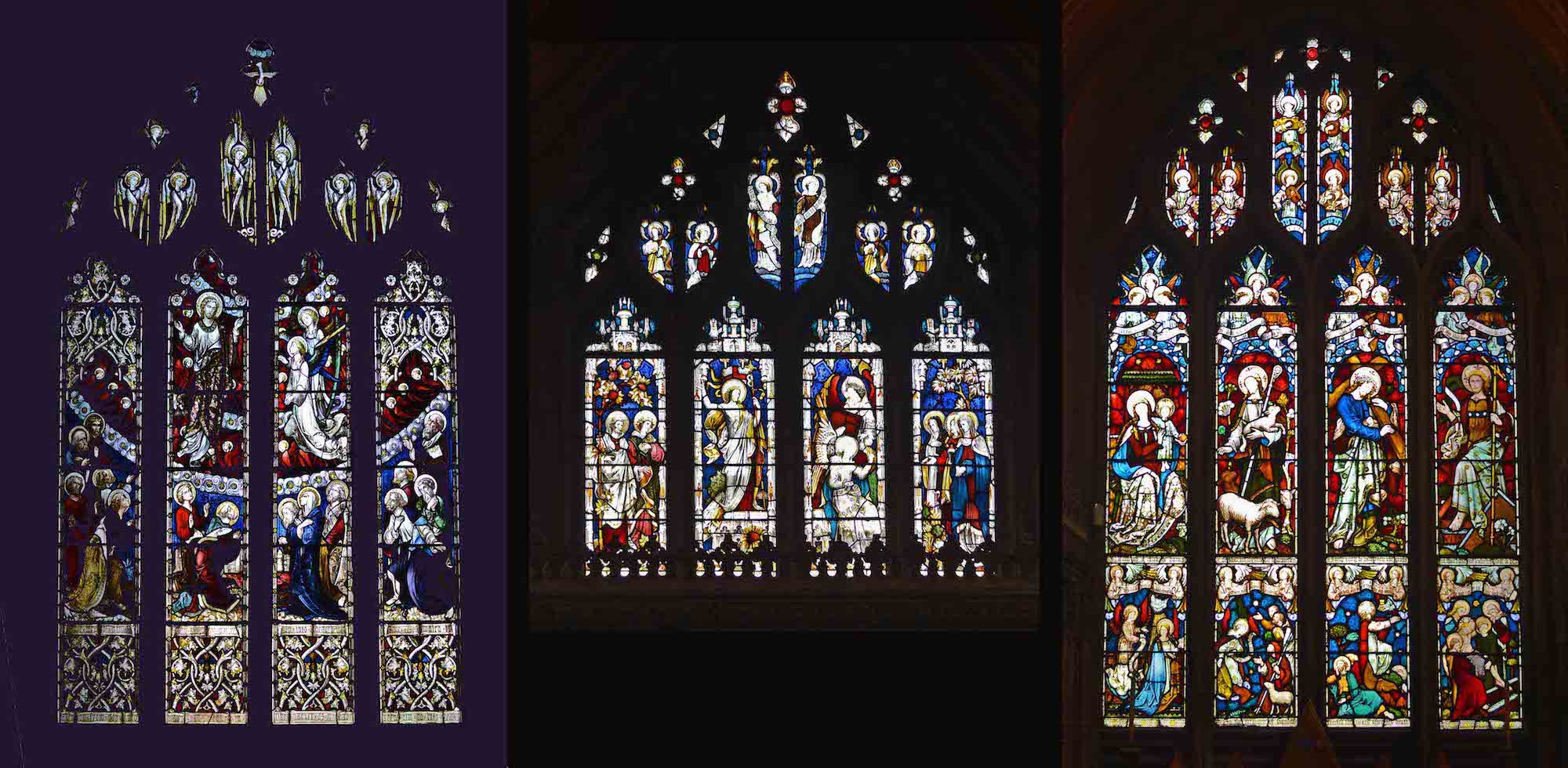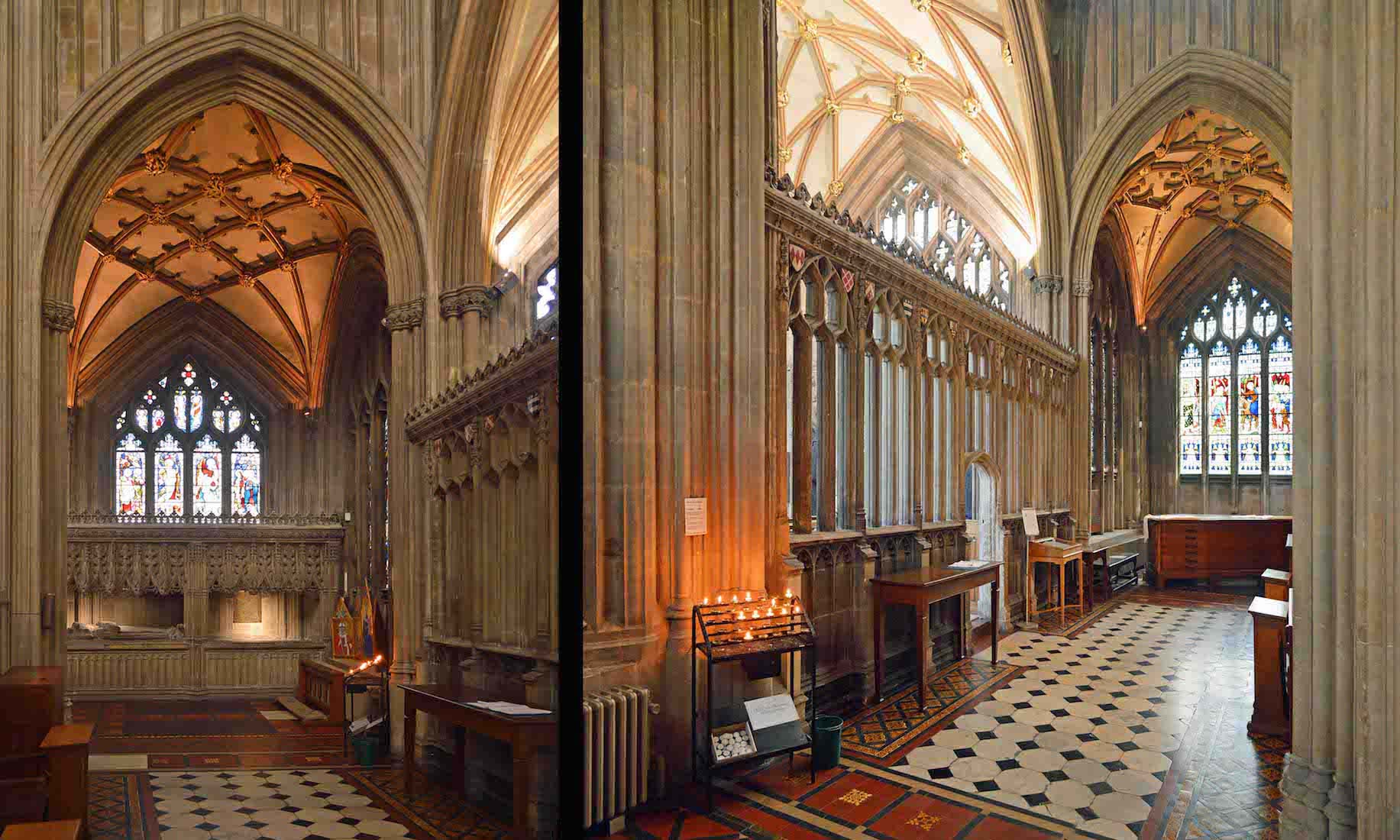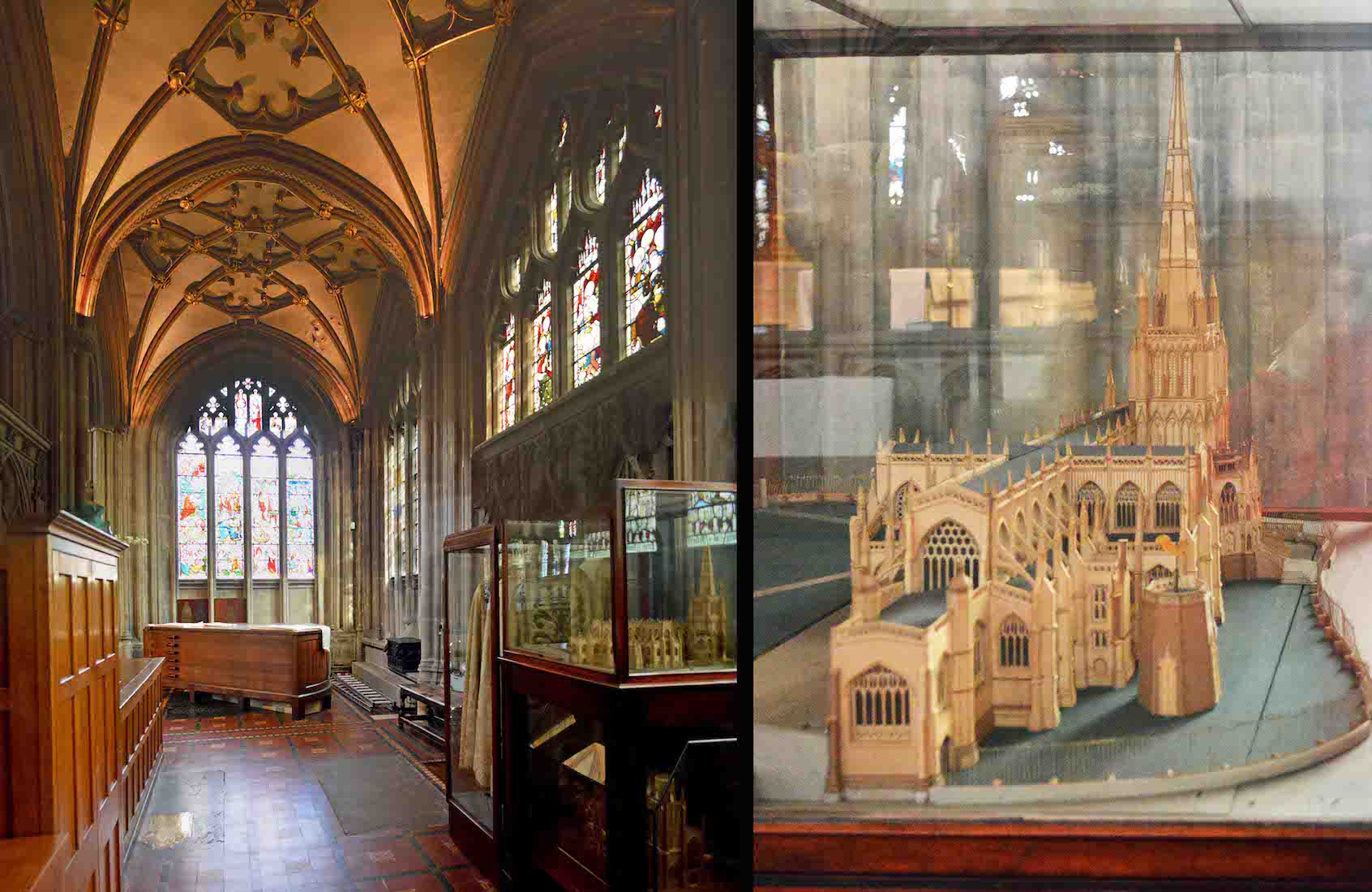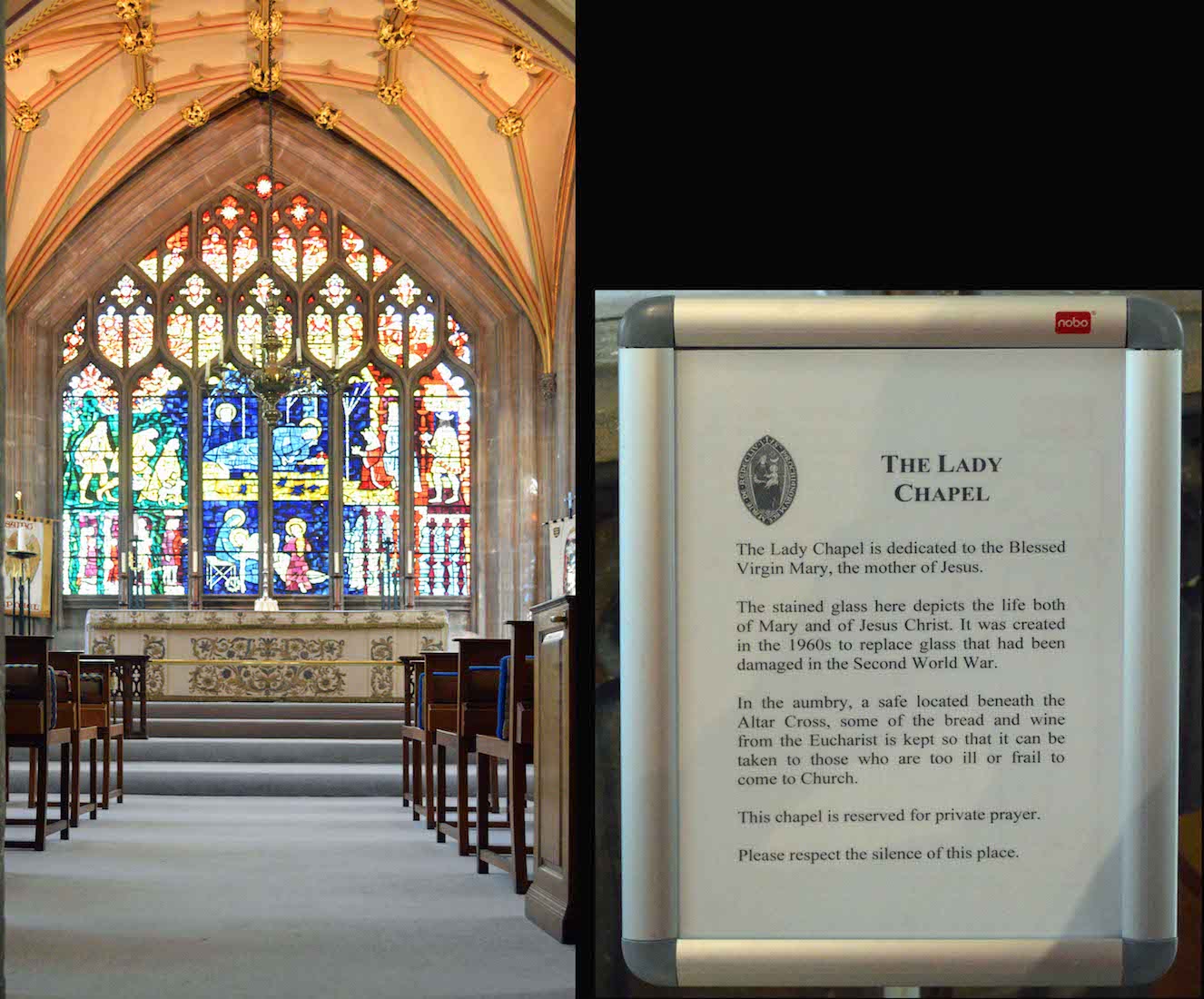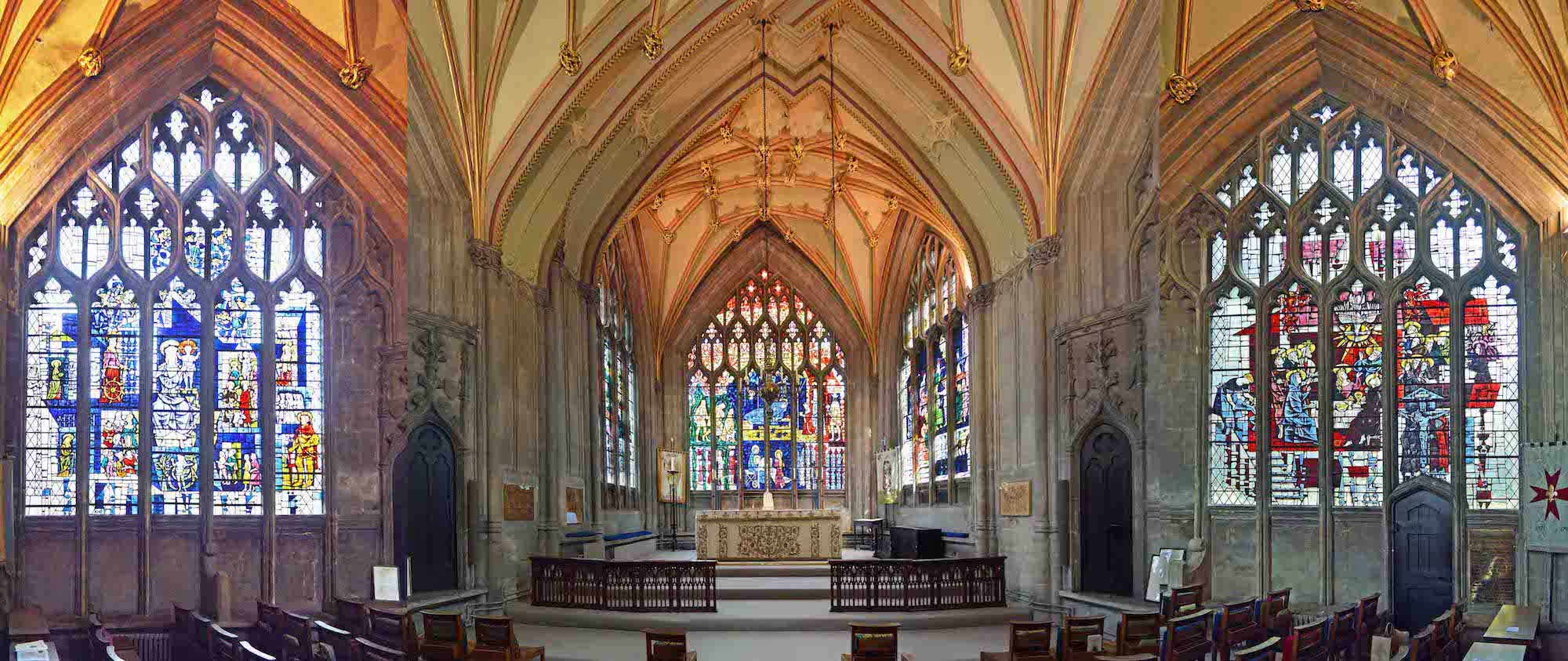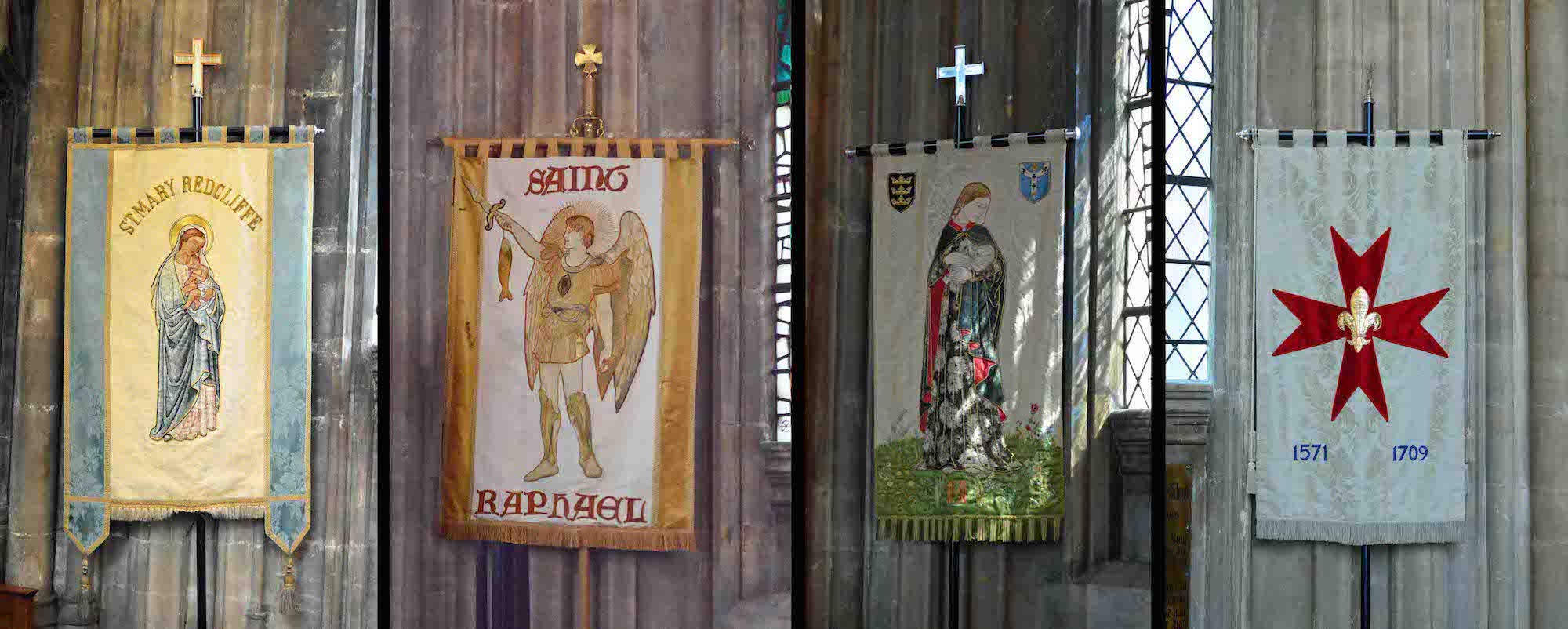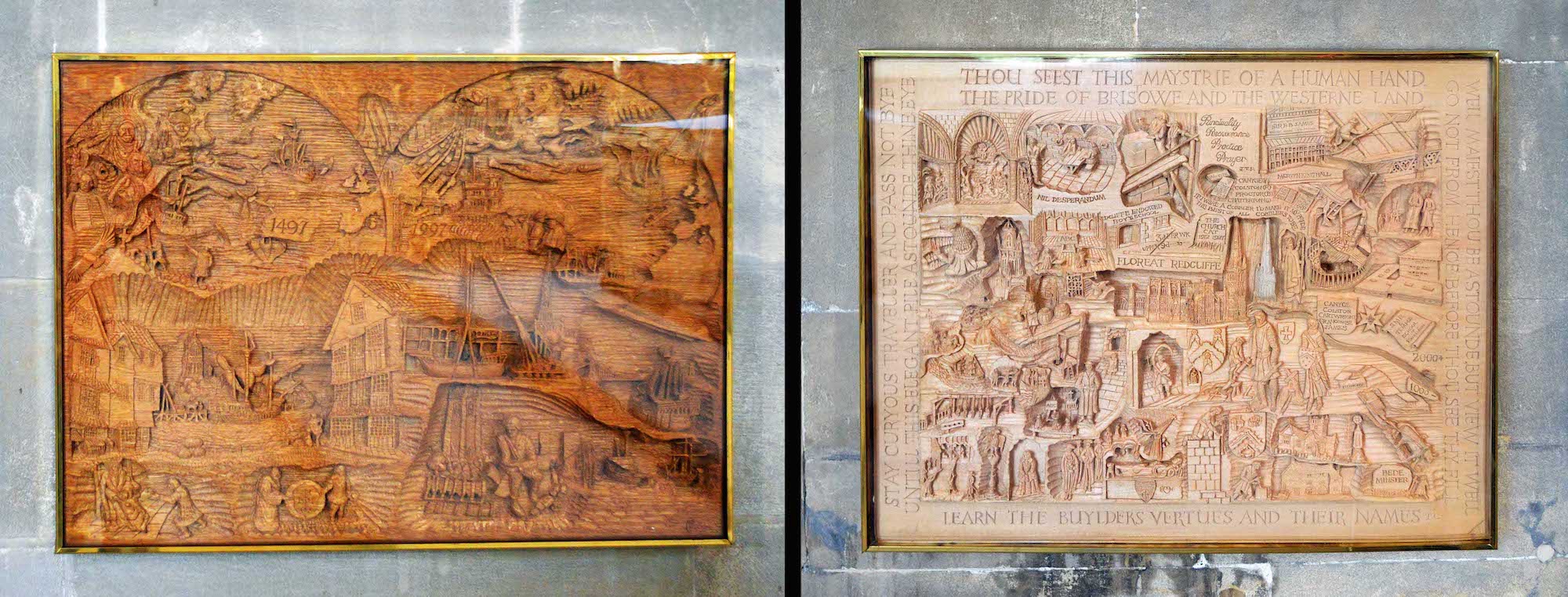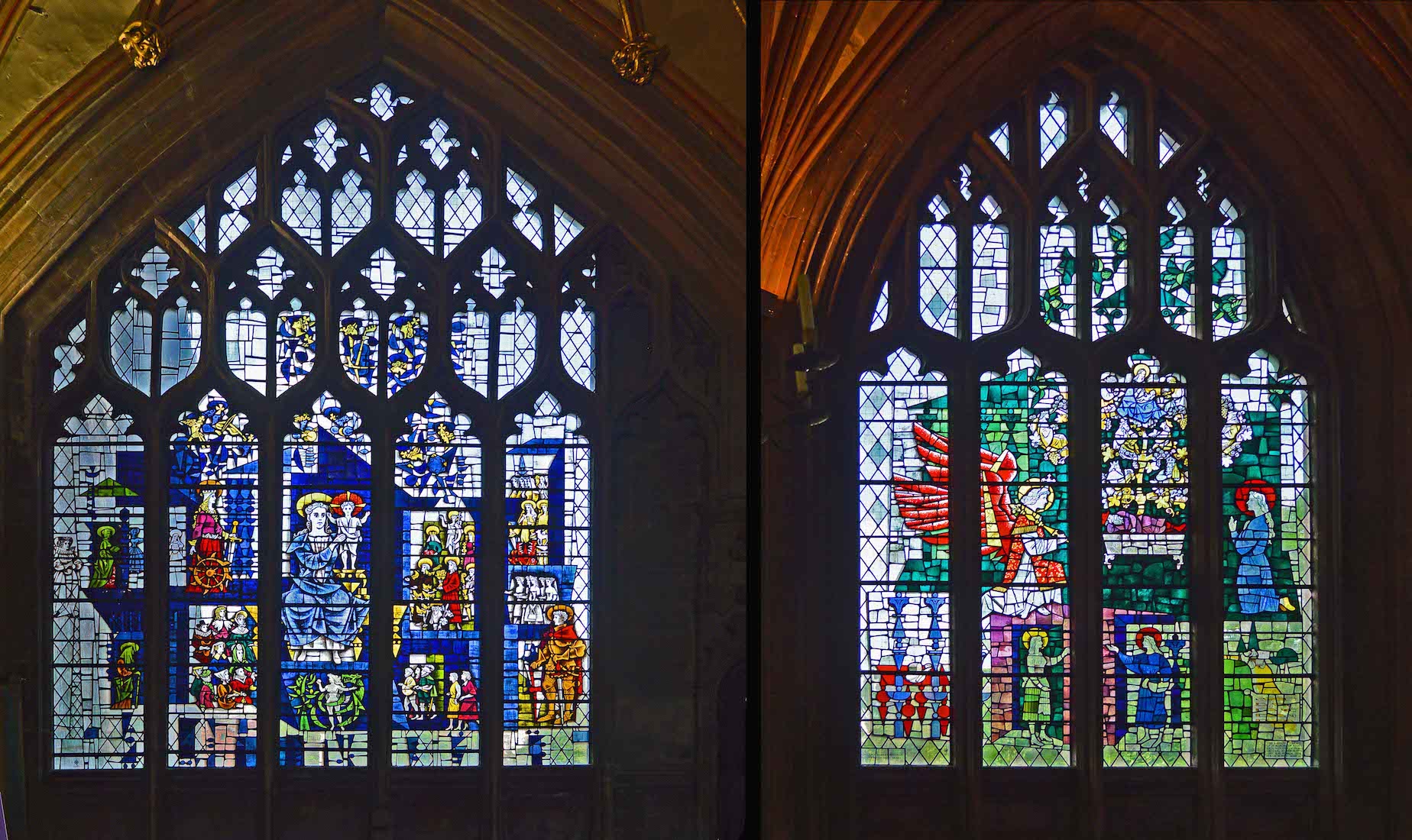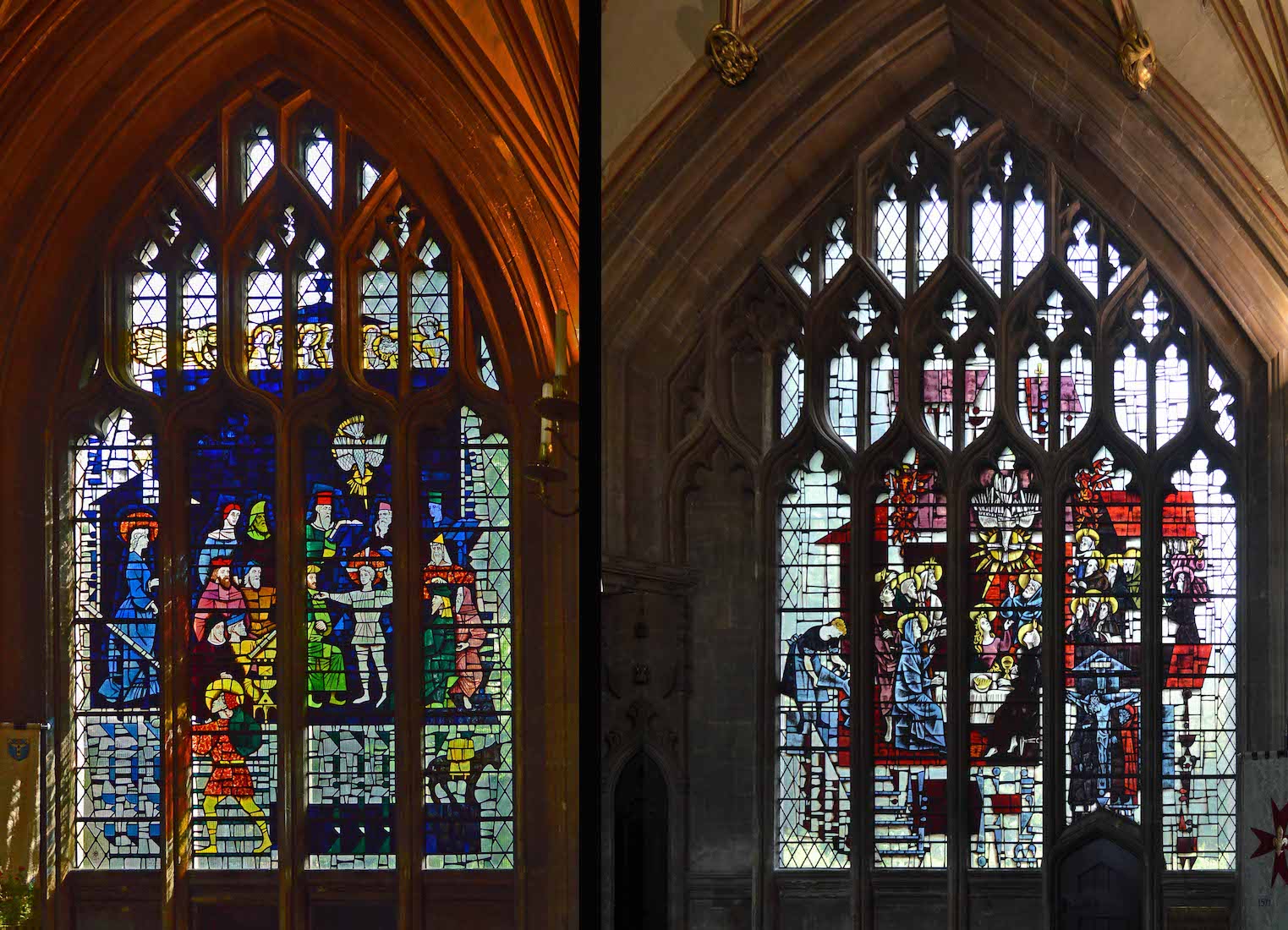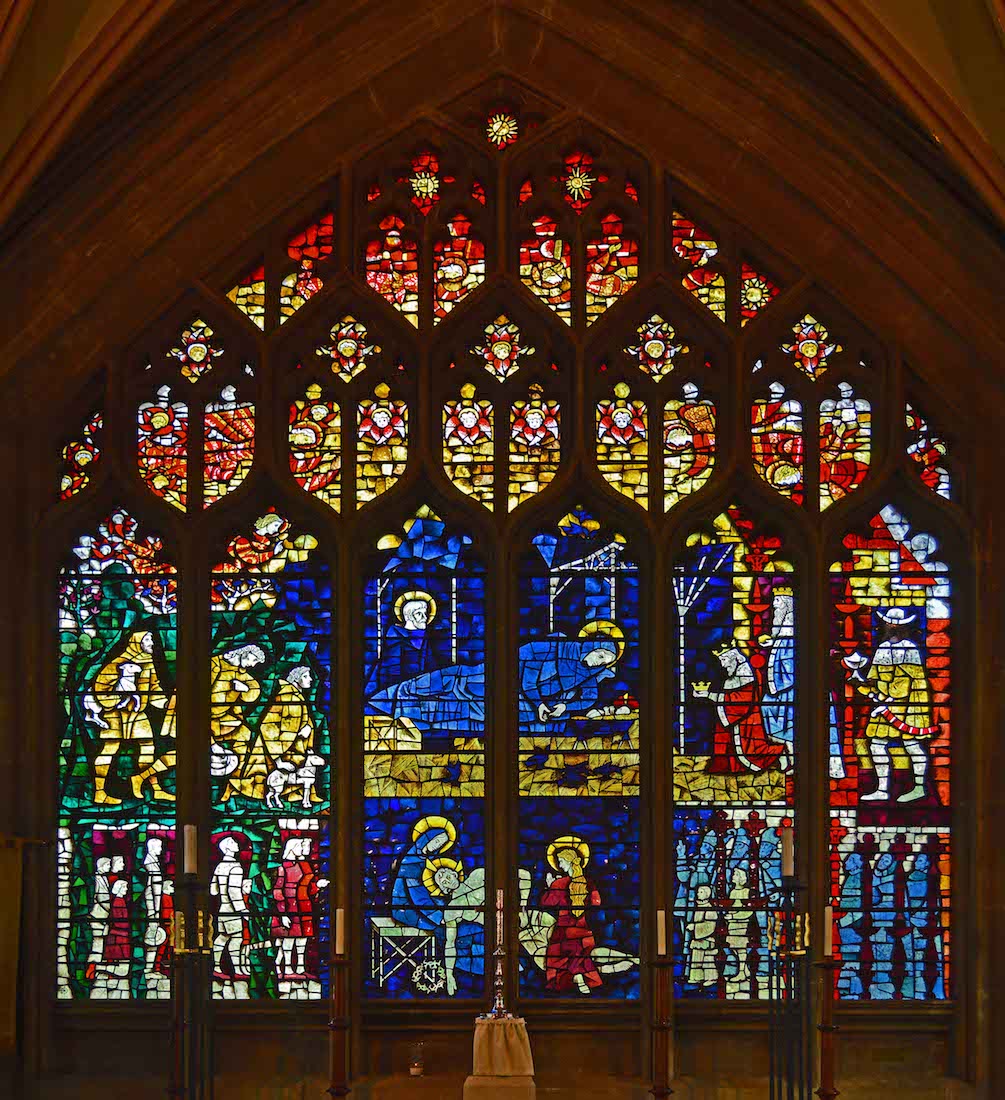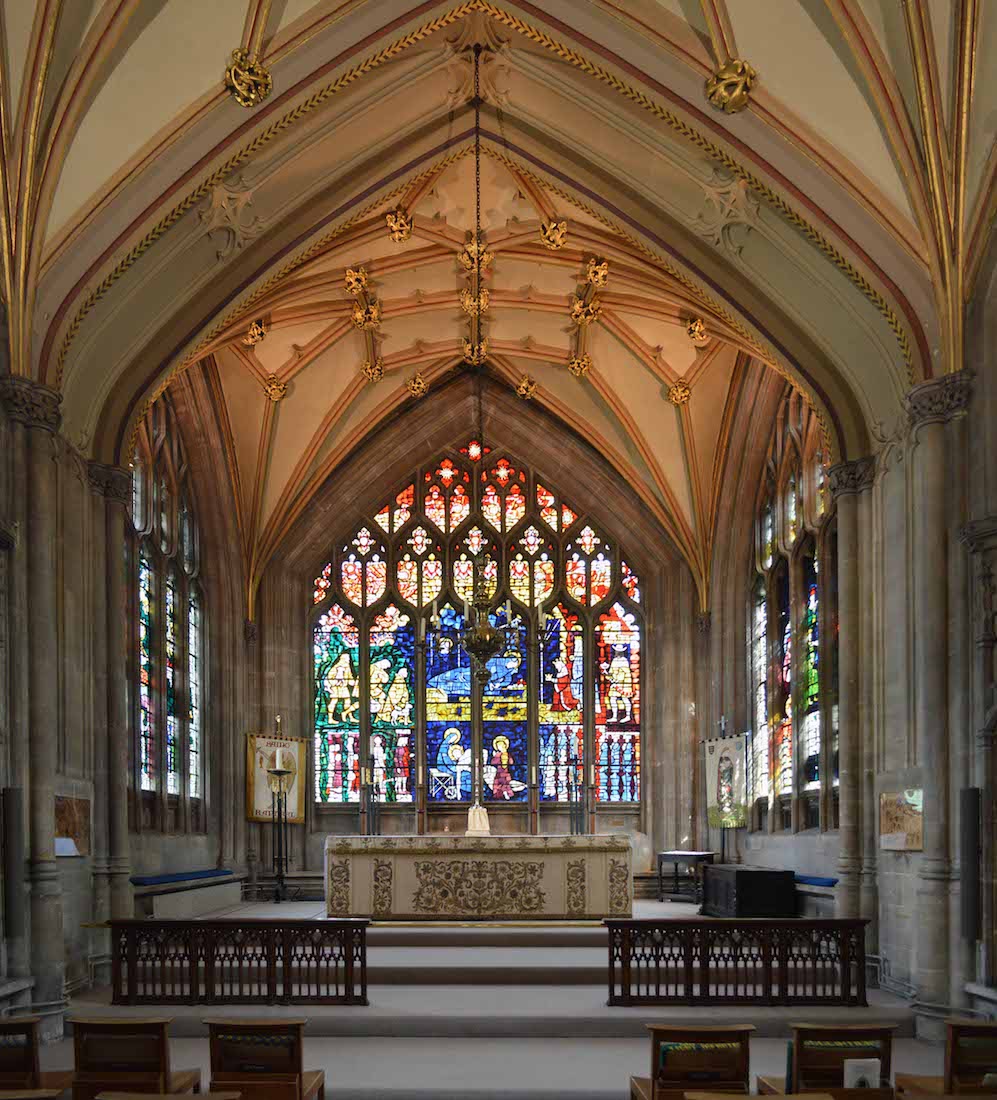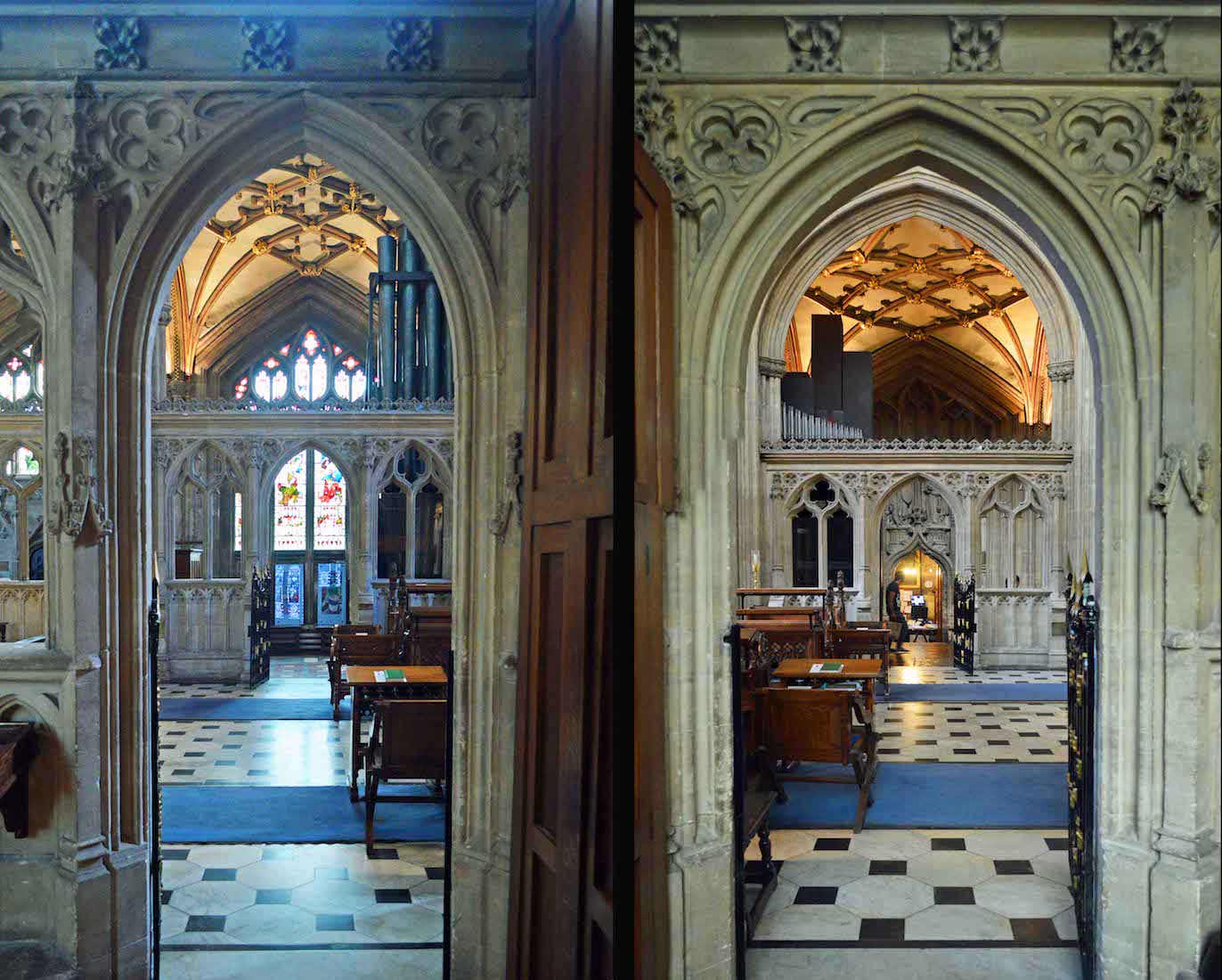
Directly opposite the office entry is another doorway leading to a walkway right across in front of the sanctuary. These are views looking South (left) and North (right). PLAN
62. NORTHEAST AMBULATORY
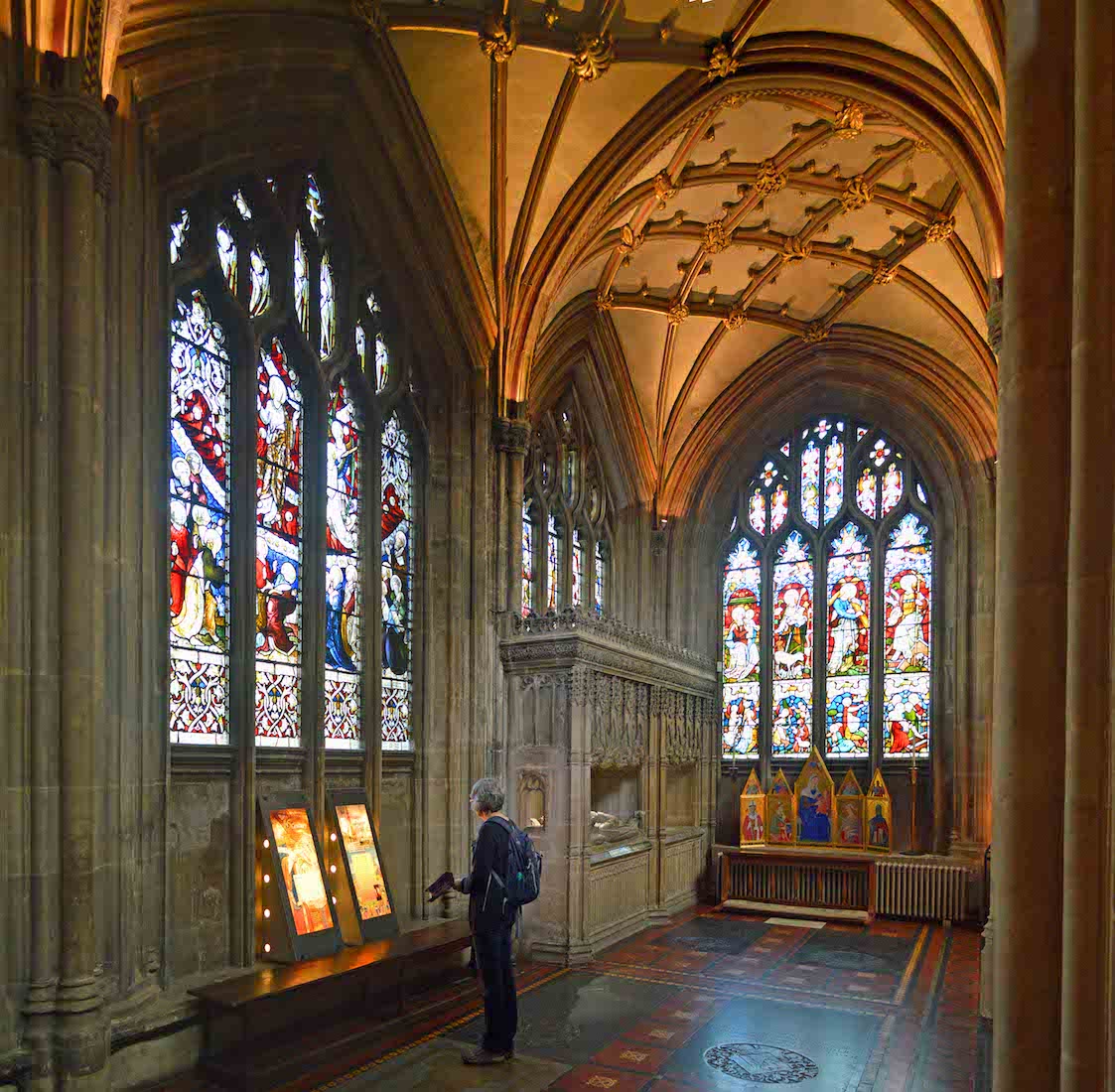
We approach the end of this short Northern ambulatory. Here there are three more windows, an end altar with some icons on it, an adjacent effigy and tomb, and closer, some illuminated Church display.
63. MEDE EFFIGY AND MODERN ICONS
At the end of the aisle is a large double tomb of 15th century architecture. Here lie the effigies of Sir Thomas Mede (1410 – 1475) and his wife. He was Bailiff of Bristol in 1439, and Sheriff in 1453. The iconic altarpiece was painted by Peter Murphy. It shows the Virgin Mary at centre with St Nicholas and St Stephen on the left, and St Catherine and St George on the right. These saints once had chapels dedicated to them in St Mary Redcliffe.
64. WINDOWS INCLUDING THE HANDEL WINDOW
The windows at left illustrate the verse Acts 1:11 : ’Ye men of Galilee, why stand ye gazing up into heaven? this same Jesus, which is taken up from you into heaven, shall so come in like manner as ye have seen him go into heaven.‘ The small window above the tomb is a garden declaration that Christ is risen. The window at right is the Handel Memorial Window, depicting scenes from ‘The Messiah’. Handel was an intimate friend ot the Vicar of Redcliffe, the Rev. Thomas Broughton (I704-1774), and is said to have revised some of his oratorios in this Church.
65. TO THE SOUTH AMBULATORY
We walk directly across to the South side of the Church from where we can look back to the Mede tomb and iconic altar piece. The Lady Chapel is now on our right, but we shall return here shortly. We continue and walk back along the South Ambulatory. Turning, we have the view shown at right. The sanctuary is now on our left, and the little doorway would lead us via the walkway to the other side. Ahead of us is the South ambulatory East window, and in front, in fact, a cope chest.
66. SOUTHEAST AMBULATORY, CHURCH MODEL
A different view, with a model of the Church on our right. Many churches and cathedrals have a model on display – some even made of matchsticks! The model is helpful to visitors in discerning the layout of the building. Below the far window is an old cope chest. This was funded by the Canynges Society in the 1930s to store the beautiful copes (highly decorated cloaks) worn by the clergy. In particular, those of the time had been embroidered by a Mrs Fry.
67. SOUTH AMBULATORY WINDOWS
These windows are shown in order, beginning with the Eastern window at left. From left we see: • scenes from Jesus praying in the garden through to carrying his Cross; • Palm Sunday; • The Last Supper; • Jesus speaking to his disciples about Mary Magdalene washing his feet (Mark 14:8); • Jesus falling under the weight of the Cross.
68. LADY CHAPEL ENTRY
The Lady Chapel, originally one bay in length (some of the old sedilia being left), was lengthened by William Canynges the younger. It was used as a Grammar School from 1766 until the restoration, and also as a Sunday School, the arch between it and the Church being walled up. Since 1854 daily Service has been held there. In the centre is the only original brass candelabrum remaining of the many by which the Church was formerly lighted. It bears the date 1650, and served as a model for the smaller ones more recently placed in the nave aisles.
69. LADY CHAPEL
This compound view of the Lady Chapel gives us some idea of its beautiful vaulting, stained glass windows, banners, wall plaques, and central altar. At extreme right in the Southwest corner there is an old brass (1571) connected with Queen Elizabeth’s Grammar School.
70. LADY CHAPEL BANNERS
There is a colourful banner in each corner of the Chapel. These are: • NW Madonna and Child, bearing the title St Mary Redcliffe; • NE St Raphael; • SE another Madonna and Child in a garden setting, sponsored by the Mothers’ Union; • SW a Maltese Cross with inset fleur-de-lis with dates 1571 and 1709. The St Mary Redcliffe and Temple School was founded in 1571. The date 1709 was the foundation date of the Temple Colston Girls’ School.
71. CHAPEL WALL PLAQUES
These plaques appear to celebrate the history of Bristol, and Redcliffe in particular. The plaque at left bears the date 1497, which was the year John Cabot set sail from Bristol for the New World.
72. CHAPEL NORTH WINDOWS
The stained glass windows in the Lady Chapel were designed and crafted in the 1960s by Harry Stammers of York. Much of the earlier Victorian glass was badly damaged in the Second World War, but these replacements contain the original dedication to those windows. The whole series of windows shows the life of Mary alongside other female saints, figures from familiar Bible stories, and groups of people dressed in the clothes of the 1950s and 60s.
73. CHAPEL SOUTH WINDOWS
The windows are obviously modern with their unconventional design. The windows contain large amounts of clear glass, which is unusual. However, here the white and tinted glass sections are not only cut into diamond shapes, but there are some beautifully designed parts where the diamonds change into irregular shapes as they border the blocks of colour. The brilliant colours in these windows are very striking.
74. CHAPEL EAST WINDOW
The East window is a beautiful Nativity window. Again the colours are brilliant. Mary reclines on the straw in the centre with Joseph and the baby Jesus nearby, and the shepherds and wise men approach from left and right. There is an interesting juxtaposition with a Pietà scene at the bottom of the window.
75. LADY CHAPEL ALTAR
This is a fine reflective place to conclude our visit to St Mary Redcliffe Church.
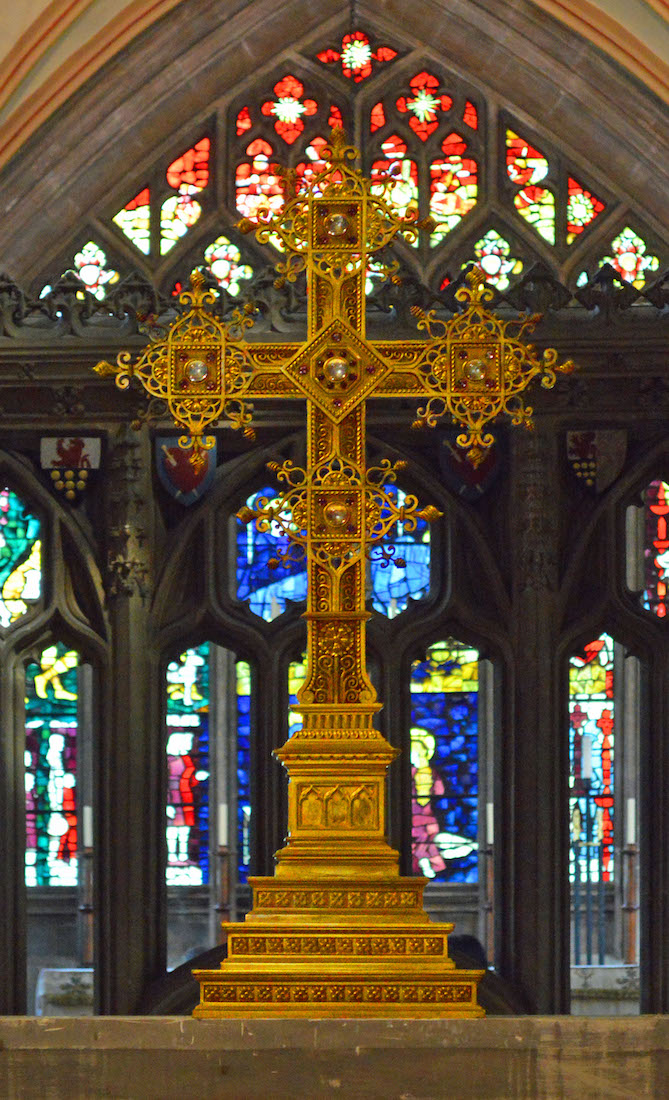
CONCLUSION
I hope you have enjoyed visiting the St Mary Redcliffe Church with me. We found it an interesting visit, and we enjoyed a Sunday service here. I am still amazed that it was built as a parish church!
I am happy to receive constructive comments or corrections concerning this website. The best websites are the ones which have no errors! I am grateful to my wife Margie who came with me, and who has proof-read these pages.
The photographs which appear on this site can also be found in higher resolution at:
https://www.flickr.com/photos/paulscottinfo/sets/
However, I take no credit for the text which comes from a variety of sources including the ever-valuable Wikipedia, and the Church tourist booklet.
St Mary Redcliffe Church also has its own website:
http://www.stmaryredcliffe.co.uk/
Paul Scott Site created 01 / 2018 ; reformatted 06 / 2020.

